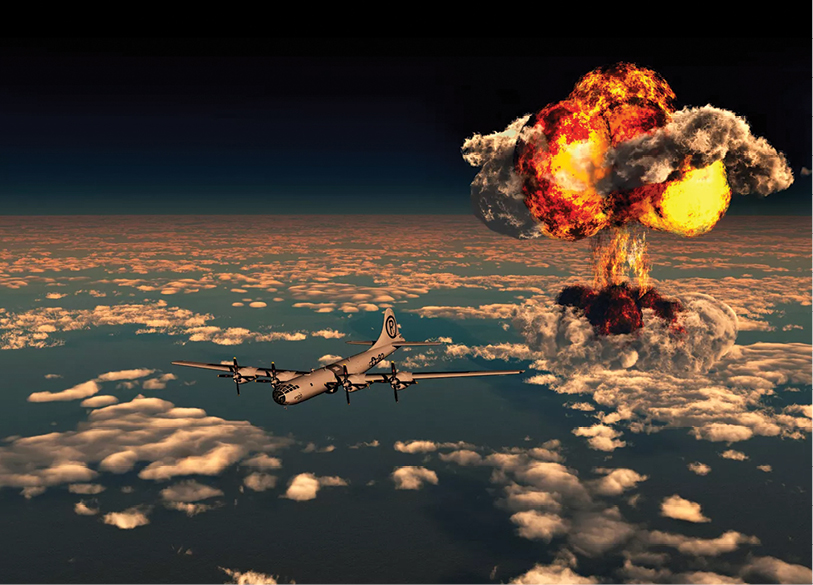
Articles
A “Mourning” in Continuum of Time: The Atomic Bombing of Hiroshima & Nagasaki
Sub Title : A brief chronology of events that preceded the atomic Bomb dropped at Nagasaki
Issues Details : Vol 18 Issue 6 Jan – Feb 2025
Author : Gp Capt DC Bakshi, VSM (Retd)
Page No. : 12
Category : Geostrategy
: January 25, 2025

The futility of war has been a recurring theme in human history. One is reminded of General William Tecumseh Sherman, whose infamous scorched-earth campaign during the American Civil War devastated the South. He later expressed profound regret:
“I am tired and sick of war. Its glory is monstrous. War is hell.”
His lament resonates deeply when reflecting on one of the darkest chapters of modern warfare: the atomic bombings of Hiroshima and Nagasaki in 1945. It is perhaps ironic that the Nobel Peace Prize in a subsequent era was awarded to Nihon Hidankyo, a Japanese organization devoted to supporting survivors of these catastrophic events.
The Dawn of the Atomic Age
In the final stages of World War II, the United States was at the height of its military and technological dominance in the Pacific. The decision to use atomic bombs marked a grim turning point in warfare.
- 6th August 1945:
Lt Gen Paul Tibbets piloted the B-29 bomber Enola Gay, which dropped the first atomic bomb, “Little Boy,” on Hiroshima. The bomb unleashed unimaginable destruction, killing an estimated 140,000 people by the end of the year.
- 9th August 1945:
A second bomb, “Fat Man,” was dropped on Nagasaki by a B-29 piloted by Lt. Gen. Charles Sweeney. The devastation was equally horrifying, with at least 70,000 lives lost by the end of the year.
The Allied Contribution to the Bomb
While the atomic bombs were built in the United States under the Manhattan Project, the United Kingdom played a pivotal role. British scientists provided critical theoretical research that helped develop nuclear weapons. Among them was William Penny, a key figure who later became known as the “Father of the British Atomic Bomb.”
Gp Capt Leonard Cheshire, a British bomber pilot who observed the Nagasaki attack, recounted in his book The Face of Victory:
“Two British observers were involved. William Penny focused on the technical aspects, while I was tasked with reporting on operational challenges.”
Reflections on the Attack
Gp. Capt. Leonard Cheshire described the moments leading up to the Nagasaki bombing. Let us read between the lines, how Cheshire unfolds the events.
“As zero-hour approached we pulled out our protective glasses – so dark that they made even the bright Japanese Sun look dimmer – but nothing happened.
We circled, circled, circled. Properly speaking we should have been in loose formation, but we had broken-up because of bad weather on the way and the rendezvous (?) had misfired. We were alone. Finally, we gave it up and set course for the second target on the other side of the island – Nagasaki.
Halfway across, the captain began to turn and said “Even a B-29 doesn’t fly forever, we will pack it up”
The Nagasaki bomb, dropped under less-than-ideal conditions, underscored the role of chance in warfare, a point Cheshire poignantly highlighted:
“Fate”, as Napoleon Bonaparte so often insisted “is inexorable in her irony”; Leonard Cheshire concludes:-
“After some hard words and some straight talking. He (Captain) changed his mind – FIFTY miles away to starboard, the bomb (on Nagasaki) went off”.
Why Two Bombings?
The rationale behind targeting two cities and the three-day interval between the bombings remains a subject of historical debate. Some argue that the bombings were intended to force Japan’s unconditional surrender, while others believe it was a demonstration of power aimed at deterring future adversaries, particularly the Soviet Union.
Japan’s military culture, steeped in the Bushido code, emphasized honor and resistance to surrender. Indeed, it was only after Emperor Hirohito’s unprecedented radio broadcast on 15th August 1945—announcing Japan’s capitulation—that the war ended.
The Human Cost
The bombings were not merely tactical maneuvers but human tragedies on an unimaginable scale. Survivors, known as hibakusha, suffered long-term effects, including radiation sickness, cancer, and psychological trauma. Many of their stories remain harrowing reminders of war’s inhumanity.
Lessons from History
The atomic bombings of Hiroshima and Nagasaki continue to serve as stark reminders of the devastating consequences of war and the challenges of achieving peace. Historian Alfred Vagts captured this sentiment:
“Terminating war is a problem as old as war itself.”
The world has since witnessed numerous efforts to prevent the use of nuclear weapons, including treaties such as the Nuclear Non-Proliferation Treaty (NPT). However, the specter of nuclear conflict remains, underscoring the urgent need for diplomacy and disarmament.


